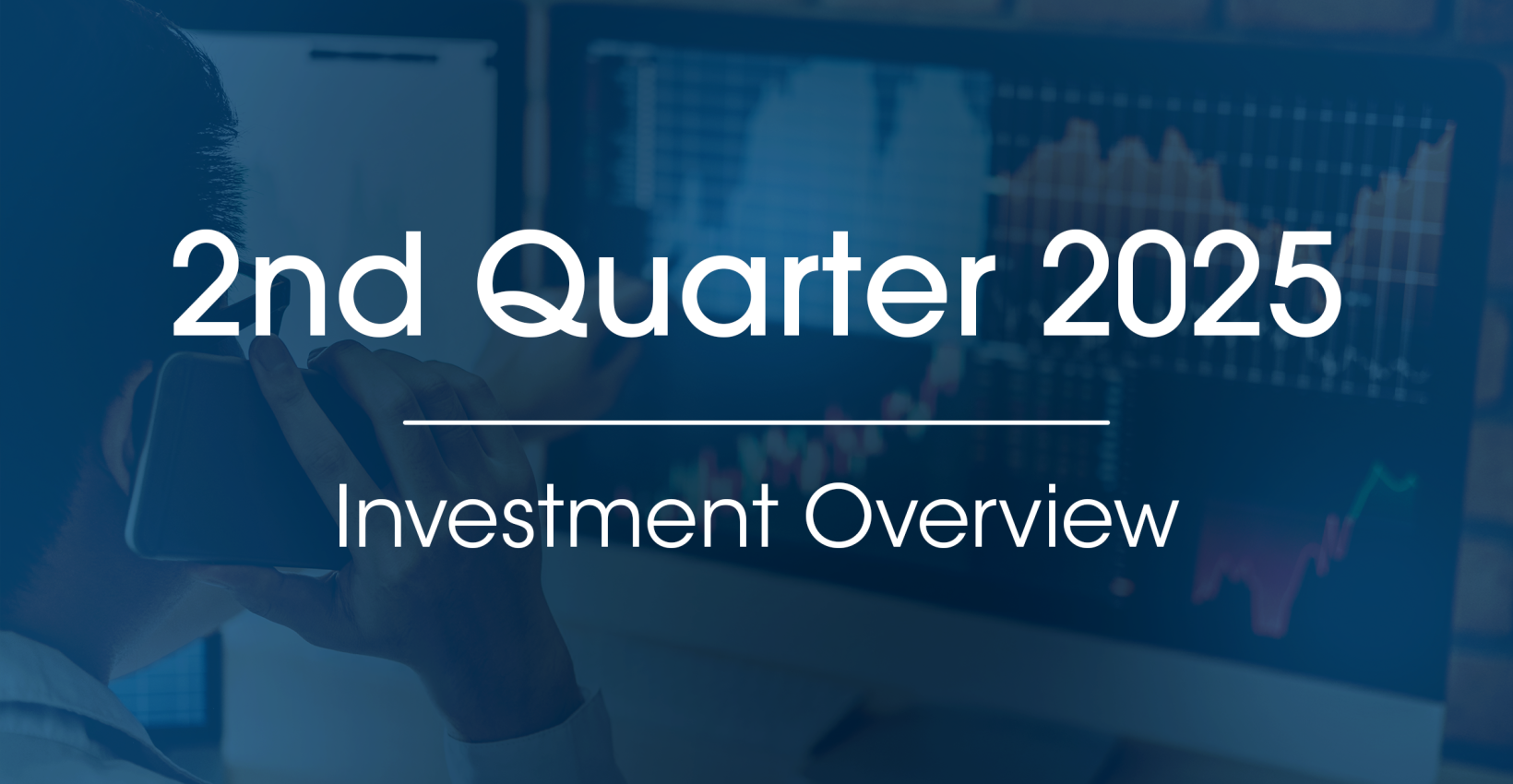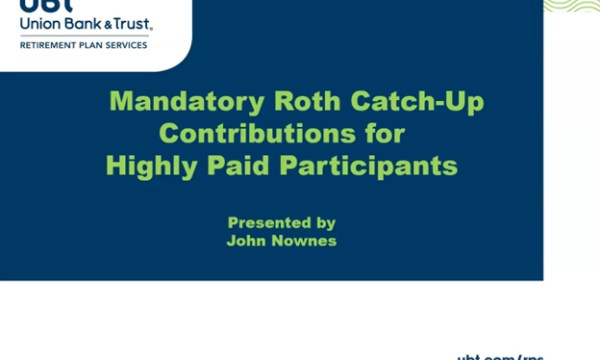Investment Overview: 2nd Quarter 2025

The economy
The second quarter of 2025 unfolded under the shadow of rising tariffs, persistent inflation, and mounting geopolitical tensions, all of which shaped a complex and cautious investment landscape. While the U.S. economy showed resilience in some areas, signs of strain became evident across several key indicators.
The quarter was dominated by the economic fallout from “Liberation Day” tariffs. The U.S. imposed sweeping new levies on multiple countries, triggering retaliatory threats and rattling global markets. While some tariff pressures have eased amidst ongoing negotiations, the current environment remains volatile. The resulting inflationary shock and earnings pressure have led to cautious guidance across retail and manufacturing sectors.
Economic growth expectations in the US moderated in Q2, with GDP forecasts revised downward to a range of 1.5%–2.5% for the year. The slowdown reflects the drag from elevated tariffs, political uncertainty, and a softening in consumer and business spending. Analysts noted that front-loading of imports in Q1 — in anticipation of tariff implementation — likely pulled forward some economic activity, leaving Q2 on weaker footing.
The labor market remained relatively solid, with a 4.2% unemployment rate reported in May. While still low, the rate has risen slightly over the past few months as slower hiring, reduced job openings and cautious wage growth suggest employers are becoming more selective amidst economic uncertainty. Meanwhile, consumer confidence plunged to its lowest level since the early months of the pandemic five years ago, driven by recession fears and inflation expectations. The Conference Board’s expectations index hit its lowest level in over a decade, signaling deepening consumer anxiety.
Inflation showed signs of easing but remains above the Federal Reserve’s target. April’s CPI rose 2.3% year-over-year, the lowest since early 2021, before ticking slightly higher to 2.4% in May. Core CPI and PCE have hovered around 2.6%–2.8%. However, tariff-induced price pressures — especially on imported goods — threaten to rekindle inflation in the second half of the year.
U.S. manufacturing activity contracted for the fourth consecutive month in June 2025, but the pace of decline eased slightly, according to the latest data from the Institute for Supply Management (ISM). The ISM Manufacturing PMI rose to 49.0, up from 48.5 in May, signaling a slower rate of contraction but still below the 50-point threshold that separates expansion from contraction. The modest improvement was driven primarily by gains in production and inventories. However, new orders and employment continued to decline, reflecting ongoing weakness in demand and hiring. Supply chain confusion and new orders weakness — largely tied to tariff uncertainty — continue to weigh on the manufacturing sector.
In late June, the U.S. launched missile strikes on Iranian nuclear facilities, marking a major escalation in tensions between the two countries. Initially, U.S. equity markets fell sharply and crude oil prices surged, but both quickly reversed as markets interpreted Iran’s response as symbolic rather than escalatory. The episode underscores the fragility of Middle East stability and its potential to disrupt global energy markets.
Globally, growth remains subdued. The Eurozone and Japan continue to struggle with low growth, while China’s outlook has declined from earlier estimates but is somewhat buoyed by the potential for fiscal stimulus. Global GDP growth projections have been trending lower, primarily due to U.S. policy uncertainty and trade disruptions.
The second quarter of 2025 underscored the fragility of the post-pandemic recovery. While inflation has cooled from extremely elevated levels and the labor market remains intact, the resurgence of protectionist trade policies and geopolitical instability have reintroduced volatility. Investors should prepare for continued uncertainty in the second half.
Fixed income
Yields were stable over the quarter at the short- and long-end of the curve, while intermediate-term bonds rallied in anticipation of additional rate cuts by year-end. The 10-year Treasury Bond finished the quarter with a yield of 4.23%, down ever so slightly from 4.21% at the start. Meanwhile, the 5-year Treasury yield decreased 15 basis points to end the quarter at 3.80%.
Given stable to decreasing rates (bond prices move inversely to interest rates), bond market performance was positive for the quarter, with the Bloomberg U.S. Aggregate Index up 1.2%. Corporate bonds outpaced their government counterparts as spreads continued to narrow.
The relatively stable rate environment may reflect a “wait and see” approach as market participants grapple with economic uncertainty. While the U.S. economy was weaker than previously thought in Q1, more current indicators (like durable goods orders) significantly surprised to the upside.
On the political front, the Trump administration’s tax and spending bill could increase the federal deficit by $3.3 trillion through 2034, according to projections. Such debt could put upward pressure on Treasury bond yields.
Adding to uncertainty will be the true impact of proposed tariffs. Although the White House has rolled back some tariffs, some remain in place and others are in flux as they linger on hold pending negotiations. In recent congressional testimony, Fed Chair Powell reiterated uncertainty about the effect on prices from tariffs, which mostly haven’t hit yet.
As expected, The Federal Reserve Open Market Committee again held rates steady at its mid-June meeting. The Fed Funds target range remains at 4.25%–4.50%. Comments suggested that the economy and jobs markets are on solid footing but risks to higher unemployment and higher inflation have increased. The Fed continues to forecast two 25-basis-point rate cuts by the end of the year.
Treasury yields of selected maturities for recent time periods are displayed below (data from Bloomberg).
| Treasury Bill | Treasury Notes & Bonds | ||||
|
3 mo. |
2 yr. |
5 yr. |
10 yr. |
30 yr. |
|
| 06/30/2025 |
4.30% |
3.72% |
3.80% |
4.23% |
4.78% |
| 03/31/2025 |
4.30% |
3.89% | 3.95% | 4.21% | 4.57% |
| 12/31/2024 |
4.32% |
4.24% |
4.38% |
4.57% |
4.78% |
Total return numbers for various fixed income indices over the past quarter and 12 months are below (data from Bloomberg).
| Fixed Income Returns | ||
| Fixed Indices | 2nd Qtr. 2025 | Last 12 mos. |
| BBerg US Aggregate Index |
1.21% |
6.08% |
| BBerg Intermediate US Gov./Credit Index |
1.67% |
6.74% |
| ICE BofA US Corporate Bond Index |
1.79% |
7.03% |
| ICE BofA US High Yield Bond Index |
3.57% |
10.24% |
| BBerg Global Aggregate Bond Index |
4.52% |
8.91% |
| ICE BofA US Municipal Security Index |
-0.16% |
0.75% |
Equities
Second-quarter equity markets posted strong returns, a welcome reprieve from the first quarter in which both the S&P 500 and the tech-heavy Nasdaq saw their biggest quarterly drop since 2022. June was a particularly strong month for stocks, with the S&P 500 and Nasdaq hitting record highs, capping a sharp rebound from April’s tariff-related dip. The S&P 500 notched its best quarterly performance since 2023 while the Nasdaq saw its biggest quarterly jump since 2020.
In reality, Q2 performance was nothing short of astonishing considering the bevy of major political and economic events disgorged upon investors. Markets somehow digested Trump’s “Liberation Day” tariff announcement on April 2, endless wrangling over a contentious budget bill, a U.S. debt downgrade, war between Israel and Iran, and the U.S. bombing of three of Iran’s nuclear enrichment sites.
Easing trade tensions and strong corporate earnings played a significant role in boosting market sentiment during the latter half of the quarter. In fact, the 55 trading days from the April 8 low to the new high on June 27 marked the fastest recovery following a 15% correction in history.
Of particular note, artificial-intelligence-related stocks regained momentum in striking fashion during the second quarter, driven by technological advancements, increased corporate investment in AI, and growing investor enthusiasm. The S&P 500 Growth and the S&P 500 Value indices notched Q2 returns of 19% and 3%, respectively, marketing the conspicuous dichotomy between the two styles.
International markets also continued to perform well with both developed and emerging markets up over 12% for the quarter, no doubt aided by a weaker dollar. International stocks have experienced strong returns over the last year. Investors in foreign markets see signs that new spending plans in countries could provide a boost for growth overseas.
The S&P 500 now trades at about 22 times its expected earnings over the next 12 months, above its 10-year average of 18.7 times. While employment remains strong and inflation has cooled a bit, we remain concerned with elevated price-to-earnings multiples as well as the heavily concentrated nature of large-cap U.S. stocks. Relative to mega-cap domestic growth stocks, we continue to find compelling value in smaller-cap and international equities.
Investors have much to ponder as we move into the second half of 2025. While company earnings are expected to remain resilient, trade wars, the uncertain impact of tariffs, Trump’s “Megabill,” and conflicts abroad are likely to add a high degree of economic and fiscal uncertainty.
Below is a table displaying various equity index returns for the past quarter (data from Bloomberg).
| Equity Indices | 2nd Qtr. 2025 | Last 12 mos. |
| S&P 500 |
10.94% |
15.14% |
| Dow Jones Industrial |
5.46% |
14.72% |
| NASDAQ |
17.97% |
15.70% |
| S&P 500 Growth |
18.94% |
19.83% |
| S&P 500 Value |
3.00% |
9.61% |
| Russell 2000 (small-cap) |
8.50% |
7.66% |
| MSCI/EAFE (developed international) |
12.04% |
18.42% |
| MSCI/EM (emerging markets) |
12.17% |
15.89% |
Sector returns
Second-quarter sector returns varied significantly as the market adjusted to a rapidly changing landscape dealing with trade negotiations and geopolitical conflicts. This backdrop led to a surprising rally which was led by growth-focused stocks, largely riding the AI wave. Interest rates remained well-behaved which aided the rally.
While the majority of sectors showed gains for the quarter, the biggest winners were the secular growth areas, including Technology and Communication Services. These sectors are dominated by mega-cap companies, many of which enjoyed significant bounces in the face of uncertainty due to their growth prospects.
Energy was the worst performer of the quarter, as it reversed course from a strong first quarter. Energy prices were volatile during the quarter due to military conflicts in the Middle East, although prices actually fell as further escalation appears to be avoided as of now. Health Care was also a relative laggard, as uncertainty abounds with possible government actions toward the sector persisting, as well as a large managed care company issuing a lower profit outlook.
As we move into the second half of 2025, many investors harbor hopes of broader stock market participation. Valuations appear stretched for some of second quarter’s winners. Further, the ultimate outcome of trade negotiations is still unknown, meaning defensive areas of the market may come back in favor with the elevated levels of uncertainty.
The following table details S&P 500 sector total returns for the quarter (data from Bloomberg).
| Return by Stock Sector | 2nd Qtr. 2025 |
| 1. Information Technology |
23.71% |
| 2. Communication Services |
18.49% |
| 3. Industrials |
12.94% |
| 4. Consumer Discretionary |
11.52% |
| 5. Financials |
5.51% |
| 6. Utilities |
4.26% |
| 7. Basic Materials |
3.13% |
| 8. Consumer Staples |
1.11% |
| 9. Real Estate |
-0.06% |
| 10. Healthcare |
-7.18% |
| 11. Energy |
-8.56% |
|
Learning Center articles, guides, blogs, podcasts, and videos are for informational purposes only and are not an advertisement for a product or service. The accuracy and completeness is not guaranteed and does not constitute legal or tax advice. Please consult with your own tax, legal, and financial advisors.




